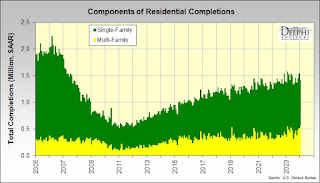Builders
started construction of privately-owned housing units in
January at a seasonally adjusted annual rate (SAAR) of 1,331,000 units (1.470
million expected).
This is 14.8% (±10.2%) below the revised December estimate of 1,562,000
(originally 1.460 million units) and 0.7% (±11.7%)* below the January 2023 SAAR
of 1,340,000 units; the not-seasonally adjusted YoY change (shown in the table
above) was -4.1%.
Single-family
housing starts in January were at a SAAR of 1,004,000; this is 4.7% (±11.6%)*
below the revised December figure of 1,054,000 units (+18.7% YoY).
Multi-family: 327,000 units (-35.6% MoM; -37.2% YoY).
* 90% confidence interval (CI) is not statistically different from zero. The Census Bureau does not publish CIs for the entire multi-unit category.
Total
completions were at a SAAR of 1,416,000 units. This is 8.1% (±10.0%)* below the
revised December estimate of 1,541,000 (originally 1.574 million units), but 2.8%
(±14.6%)* above the January 2023 SAAR of 1,377,000 units; the NSA comparison: +1.6%
YoY.
Single-family completions were at a SAAR of 857,000; this is 16.3% (±7.9%) below the revised December rate of 1,024,000 units (-17.0% YoY). Multi-family: 559,000 units (+8.1% MoM; +57.1% YoY).
Total
permits were at a SAAR of 1,470,000 units (1.510 million expected). This is 1.5%
below the revised December rate of 1,493,000 (originally 1.495 million units)
but 8.6% above the January 2023 SAAR of 1,354,000 units; the NSA comparison: +11.6
YoY.
Single-family permits were at a rate of 1,015,000; this is 1.6% above the revised December figure of 999,000 units (+42.0% YoY). Multi-family: 455,000 units (-7.9% MoM; -22.1% YoY).
Press
release from NAHB’s Robert Dietz:
“Expectations
that mortgage rates will continue to moderate in the coming months, the
prospect of future rate cuts by the Federal Reserve later this year, and a
protracted lack of existing inventory helped provide a boost to builder
sentiment for the third straight month.
“Builder
confidence in the market for newly built single-family homes climbed four
points to 48 in February, according to the National Association of Home
Builders (NAHB)/Wells Fargo Housing Market Index (HMI). This is the highest
level since August 2023.
“Buyer
traffic improved at the start of 2024, as even small declines in interest rates
produce a disproportionate positive response among likely home purchasers. And
while mortgage rates still remain too high for many prospective buyers, we
anticipate that due to pent-up demand, many more buyers will enter the
marketplace if mortgage rates continue to decline this year.
“With
expectations of Fed rate cuts in the latter half of 2024, NAHB is forecasting
that single-family starts will rise about 5% this year. But as builders break
ground on more homes, lot availability is expected to be a growing concern,
along with persistent labor shortages. And as a further reminder that the
recovery will be bumpy as buyers remain sensitive to interest rate and
construction cost changes, the 10-year Treasury rate is up more than 40 basis
points since the beginning of the year.
“With
mortgage rates now below 7% since mid-December, more builders are cutting back
on reducing home prices to boost sales. In February, 25% of builders reported
cutting home prices, down from 31% in January and 36% in the last two months of
2023. However, the average price reduction in February held steady at 6% for
the eighth straight month. Meanwhile, the use of sales incentives is also
diminishing. The share of builders offering some form of incentive dropped to
58% in February, down from 62% in January and the lowest share since last
August.”
The foregoing comments represent the general economic views and analysis of Delphi Advisors, and are provided solely for the purpose of information, instruction and discourse. They do not constitute a solicitation or recommendation regarding any investment.












No comments:
Post a Comment
Note: Only a member of this blog may post a comment.